This Is How To Bring Dark Skies Back In An Increasingly Developed World
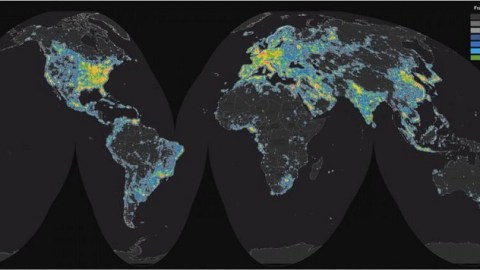
Well-lit cities and towns are essential to public safety. That doesn’t have to ruin the night sky.
For most of us here on planet Earth, navigating the world at night is just a little more challenging than during daytime. Without the Sun’s bright light to illuminate our world, our eyes do their best to adapt. Our color-sensing cones move back in our eyes while the monochrome-sensitive rods move forward. Our pupils dilate to larger diameters, letting more light in. Even in the wild, the Moon and stars provide enough light for a sufficiently dark-adapted eye to make out shapes and objects.
Evolutionarily, this was a spectacularly useful adaptation. Human vision may be optimally suited to daytime vision, but the ways our eyes adjust also allow us to perceive the Universe far beyond our world. Unfortunately, our connection with the night sky has been severed by a truly human endeavor: artificial lighting. While the benefits to public safety and commerce are inarguable, the tradeoff is unnecessary. Light pollution may a worse problem than ever, but it doesn’t have to be this way.

From a truly dark site — on a moonless night where there’s less artificial light generated on Earth than is incoming from the night sky — thousands of stars, multiple planets, the plane of the Milky Way galaxy, and up to four other galaxies beyond our own can be seen. Yet dark sites are becoming harder and harder to find, as the rise in artificial lighting has followed humanity wherever our species has settled. 80% of the entire world, including 99% of Europe and the United States, lives under light-polluted skies, where the Milky Way is never visible even under ideal weather conditions.
For most of us, we so thoroughly accept this as normal that our thoughts of a spectacular night sky only arise when we envision a trip to the countryside, a national park, or some other location sufficiently divorced from the trappings of our modern world. If tensions ever exist between a naturally beautiful sight and providing well-lit streets and sidewalks, the pro-lighting side always wins.

This has resulted in gains that are measurable in terms of economics, but losses that are of extraordinary consequence. While there are the immeasurable losses that the lack of dark skies brings us — in terms of humanity’s connection to the Universe beyond our local, day-to-day concerns — there are quantifiable ramifications to humans and animals as well. For example, artificial lighting demonstrably causes:
- short-term and long-term disruptions to the natural circadian rhythms of humans and other animals,
- the environmental impacts of carbon emissions to the tune of 114 TWh annually for street lighting alone,
- and resultant behavioral changes in animals concerning mating, movement, migration, communications and mortality.
There may be many great benefits to having well-lit streets, residences, businesses, and other public and private establishments, but there are enormous negatives as well. As human civilization continues to develop, this problem has only increased in severity.
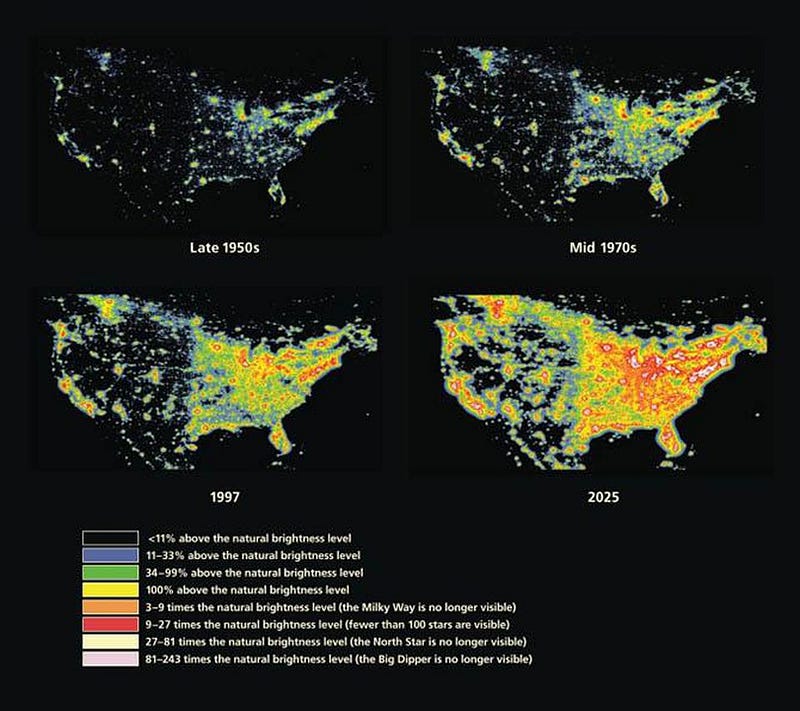
The rise of LED and metal halide lighting has proven more energy efficient, but also produces more omnidirectional blue light: the most impactful wavelengths of light to plants and animals. As the effective temperature of artificial lighting goes up, so do the effects of light pollution. Increasing the lighting temperature from 3000 K (which is recommended by the International Dark Sky Association) to 4000 K results in a 250% increase in light pollution, and going to full-spectrum LED lights exacerbates the problem even further.

(WIKIMEDIA COMMONS USER LUCASVB, ADDITIONS BY E. SIEGEL)
Put very simply, light pollution harms the environment and obscures the night sky. It’s the latter effects, perhaps, that are the most visually striking. Owing to global surveys of humans who’ve been noting the difference in what’s actually visible in the night skies themselves, we’ve learned that natural levels of darkness are increasingly difficult to find.
Originally put forth by amateur astronomers, the widely-used Bortle Dark Sky Scale relates what’s visible in the sky to the light pollution that we see. Even in small towns of only a few hundred or thousand people, artificial lighting can easily transform skies that might be a 3 or 4 to a disappointing 7 or 8, or even higher.
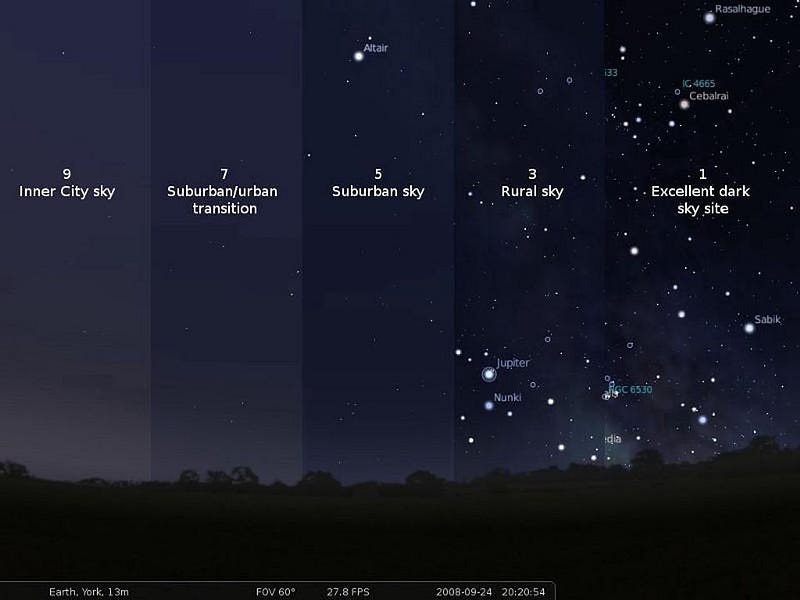
But this doesn’t need to be the cost of civilization. For over 30 years, professional and amateur astronomers have been working together as part of the International Dark-Sky Association (IDA), whose mission is “to preserve and protect the night time environment and our heritage of dark skies through quality outdoor lighting.” If you don’t learn anything else about dark skies or the IDA, there is one major lesson you should take away:
There is a difference between well-lit and brightly-lit, and you can have a well-lit city or town while still enjoying the benefits of dark skies and low levels of artificial light pollution.
If you live in or near one of the most heavily light-polluted cities of all, like New York, Los Angeles, or Chicago, you might be shocked to learn that our artificial lighting outshines the natural brightness of the sky by many hundreds of times (or even greater amounts).
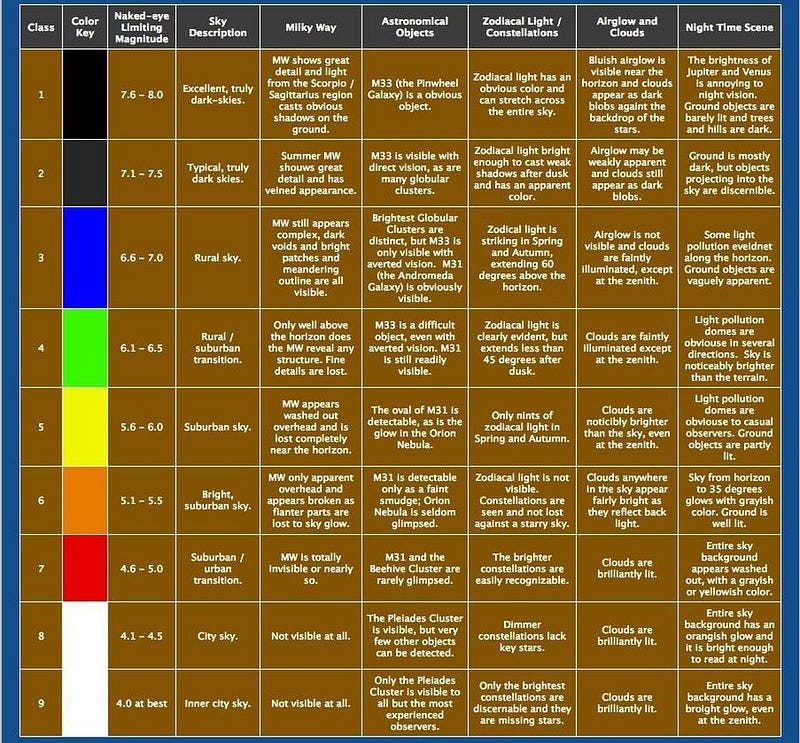
Thankfully, a sufficiently motivated town, city, or community can take tangible steps towards preserving the natural darkness of the environment while still maintaining all the benefits of having well-lit cities and public/private spaces. The IDA presently lists 22 cities or communities that are recognized for their exceptional dedication to the preservation of the night sky. The steps to get there are simple but powerful, and include:
- implementing and enforcing a quality outdoor lighting ordinance,
- demonstrating citizen support for dark skies,
- and implementing dark sky education and awareness.
By promoting responsible lighting that focuses on well-lit, low-temperature areas, we can all work towards being better stewards of the night sky, the environment, and set a good example for all of the surrounding communities.

These solutions include many options that motivated citizens can get started with, even on their own, right away. Light fixtures commonly shine omnidirectionally, including upwards and horizontally, which is where the greatest environmental impacts on our skies and on our health arise from. However, replacing old, omnidirectional fixtures with downward-shining fixtures can maintain the benefits of well-lit areas while removing many of the negative impacts of light pollution.
You might object that there’s a substantial up-front cost to redoing so much of the exterior lighting, and that’s a reasonable concern. However, you may want to consider that could be offset by long-term savings, as fixtures that point their light downwards are essentially redirecting much of the wasted light that normally shines horizontally and vertically towards newly useful purposes. These pollution-reducing fixtures also lower the overall amount of electricity needed to produce the same amount of well-lit, usable luminance over a particular area.
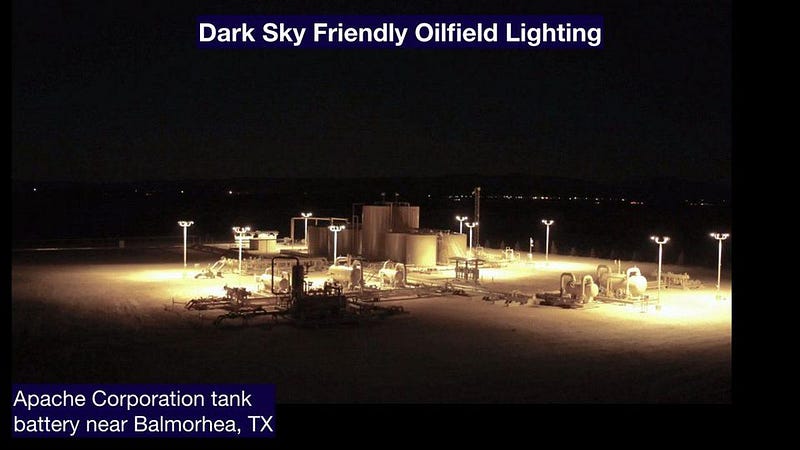
You may be wondering whether your city or town can become an IDA-recognized dark sky community, and not only is the answer yes, but the IDA makes it easy to inquire online as to how your community, complete with its specific needs, can become recognized by the IDA. The benefits of darkness at night are still being uncovered, as are the health and wellness costs of the loss of such darkness, but this is a problem that we can do something substantial about. All it takes is simply investing in more efficient, effective lighting infrastructure.
By switching to:
- the proper temperature street lights,
- improved fixtures and exterior lights on residences and businesses,
- a conscientious switch to low-temperature bulbs,
- and a committed, aware citizenry
any community can begin reaping the benefits of dark nighttime environments without sacrificing safety or commerce.
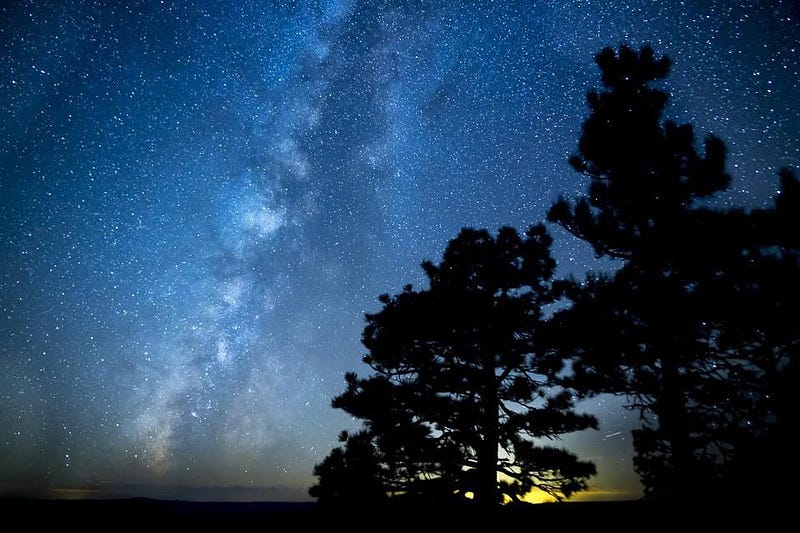
A dark night sky is something we not only all deserve, it’s something that we could very easily have for a relatively small investment. The benefits, in addition to long-term cost savings, education, and the environmental positives, can be taken in all at once by everyone who both lives in, or simply passes through, your town.
And for those of you still asking, “what benefit is that?”
As soon as you encounter your first dark sky community, you’ll see for yourself that there’s no explanation required. To take it all in, just look up.

Ethan Siegel is the author of Beyond the Galaxy and Treknology. You can pre-order his third book, currently in development: the Encyclopaedia Cosmologica.





